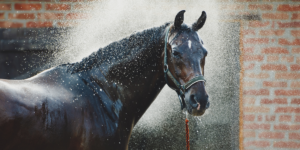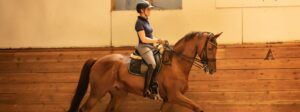Andrew McLean and the 10 principles of training you need to be aware of
We all know these moments that you ask A and your horse does B. When you’re having miscommunication with your horse, it is of importance to figure out why that happened instead of getting angry with your horse.
Especially when, as a result, the level of tension rises.
In that situation your horse can’t think properly anymore due to the release of stress hormones like cortisol. So you can imagine giving your aids when your horse in survival mode has a different outcome than when he’s relaxed and he has the right mindset for learning.
So we want to prevent high levels of tension and stress in order for you to be able to effectively train your horse.
Fortunately, the Australian scientist Andrew McLean does a lot of research on this topic. He has put together ten principles of training that you should incorporate in your training at any time.
When your horse is in a survival mode he wil respond differently to your aids
He already had eight principles but recently he revised them and added two principles.
Ten principles of training you must adopt in your training
So do
1. Train according to the horse’s ethology and cognition
We should not overerestimate the learning capabilities of our horses and at the same time underestimate them by suggesting that they do not have emotions and feelings. Besides we have to keep in mind what the natural behaviour of our horses implies, like for example that they are social animals and their digestive systems are based on grazing 16 hours a day.
2. Use learning theory appropriately
Make sure you use habituation, (de)sensitisation, operant conditioning, shaping and classical conditioning in the right way. Read more about that here.
3. Train easy-to-discriminate signals
Do you have different and easy-to-discriminate aids for a the different movements, like gait transitions? If this isn’t clear to your horse, this will most likely lead to stress.
4. Shape responses and movements
Make sure you take small steps when teaching your horse new movements and responses and build from there. Reward your horse when he makes a baisc attempt and build from there to eventually get the right response.
Make sure you take small steps when teaching your horse new movements and responses and build from there.
5. Elicit responses one-at-a-time
Don’t give multiple aids at once but make sure there’s time inbetween the different aids. The actual time depends on the training level of your horse. But if you give multiple aids at once, you run the risk of desensitisation, which we want to prevent in dressage.
6. Train only one response per aid
Does every aid lead to a single response? Don’t ask for multiple responses when giving a single aid. Above all, rein and leg aids should be separated.
7. Form consistent habits
Be consistent in how you teach your horse new exercises and movements. Use the same signals in the same way at the same place. Once that’s reinforced you can start making gradual changes.
8. Train persistence of responses
Teach your horse to ‘keep going’ in rhythm, straightness and outline so that you don’t have to constantly give aids and run the risk of your horse getting used to your aids and becoming dull.
9. Avoid and dissacoiate flight responses
Flight responses with a high level of stress have several negative consequences, like learning and memory deficits, long-term insecurity and digestive disturbances.
10. Try to obtain the optimal level of arousal
When training the level of tension shouldn’t be too high and there should be an appropriate level of relaxation. At the same the level of tension has to be high enough to get the required muscle tone and attentiveness.
you want to know if your training method is effective and respects the learning capabilities of your horse? Find out below!





2 Reacties
My horse was tense and panicked when he was at the trainer’s. They couldn’t do anything with him so I brought him home. He learned nothing. I now have him relaxed with the training thanks to TRT but sometimes he is too relaxed. so number 8, keeping him going is a challenge. Also number 10. He is either half asleep or on high alert. I need the happy medium
Thank you so much , it make sense to me .